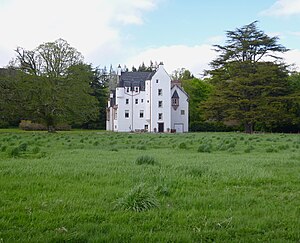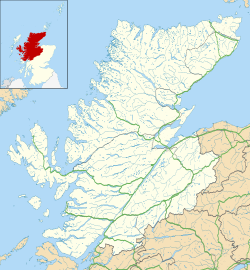History in the 20th century
After the death of the last surviving member of the direct line of Chisholms the estate was owned by the trustees of the late Lady Chisholm, Annie Cecilia Chisholm of Chisholm. [3] In 1932–33 the Estate Manager was recorded as William Macintyre, and he lived at the Sawmill Cottage. [4] [5]
The Highland News, 17 April 1937, states that the Chisholm Estates had been sold on 10 April 1937 to an unknown buyer. The lands were said to have included Erchless Castle and Forest, with deer in the forests of Affric, Fasnakyle, Cozac, Benula together with the outlying estates of Buntait, Kerrow and Rheindown. The buyer was Highland Estates Ltd. [6]
In 1946 the Erchless Estate and castle were bought on behalf of Baron Siegfried Nikolai von Stackelberg, an anti-communist refugee member of the Baltic German nobility and his wife Baroness Phyllis von Stackelberg. The funds came from the estate of her father George Roscoe, a member of the firm James Roscoe & Sons. The Estate continued in the ownership of the Trustees of George Roscoe until 1963–64, but the Valuation Roll for the following year names the new Lairdship of Erchless (estate) as being held by the family of Sir Lawrence Robson, founder of accountancy firm Robson Rhodes. [7] [8]
However, the Trustees did not sell the whole of the former Erchless Estate: the Valuation Roll for Kilmorack for 1964–65 records them as still owning Teanassie House, and most of Breakachy. Baron and Baroness von Stackelberg had moved into Teanassie House to live in retirement. Their gravestone reads: "In memory of Baron Nicholas Stackelberg of Teanassie House, much loved husband of Phyllis, died 30 September 1966. Phyllis Mary Roscoe died 21 March 1982." [9]
On the death of Sir Lawrence Robson in 1982, the castle was inherited by his son, Erik Maurice William Robson. [10]

Baron is a rank of nobility or title of honour, often hereditary, in various European countries, either current or historical. The female equivalent is baroness. Typically, the title denotes an aristocrat who ranks higher than a lord or knight, but lower than a viscount or count. Often, barons hold their fief – their lands and income – directly from the monarch. Barons are less often the vassals of other nobles. In many kingdoms, they were entitled to wear a smaller form of a crown called a coronet.

Baron Clinton is a title in the Peerage of England. Created in 1298 for Sir John de Clinton, it is the seventh-oldest barony in England.
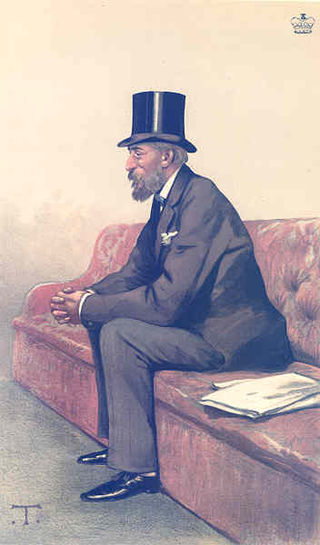
Ivor Bertie Guest, 1st Baron Wimborne, 2nd Baronet, DL was a British industrialist and a member of the prominent Guest family.
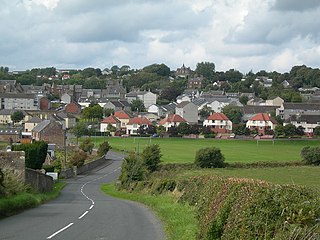
Maybole is a town and former burgh of barony and police burgh in South Ayrshire, Scotland. It had an estimated population of 4,580 in 2020. It is situated 9 miles (14 km) south of Ayr and 50 miles (80 km) southwest of Glasgow by the Glasgow and South Western Railway. The town is bypassed by the A77.

In Scotland, a baron or baroness is the head of a feudal barony, also known as a prescriptive barony. This used to be attached to a particular piece of land on which was situated the caput or essence of the barony, normally a building, such as a castle or manor house. Accordingly, the owner of the piece of land containing the caput was called a baron or baroness. According to Grant, there were around 350 identifiable local baronies in Scotland by the early fifteenth century and these could mostly be mapped against local parish boundaries. The term baron was in general use from the thirteenth century to describe what would have been known in England as a knight of the shire.
A laird is the owner of a large, long-established Scottish estate. In the traditional Scottish order of precedence, a laird ranked below a baron and above a gentleman. This rank was held only by those lairds holding official recognition in a territorial designation by the Lord Lyon King of Arms. They are usually styled [name] [surname] of [lairdship]. However, since "laird" is a courtesy title, it has no formal status in law.
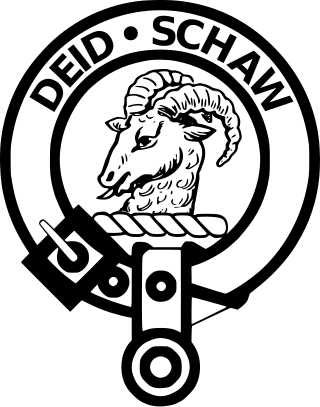
The Clan Ruthven is a Lowland Scottish clan.

Beauly is a village in the Highland area, on the River Beauly, 12 miles (19 km) west of Inverness by the Far North railway line. The town is historically within Kilmorack Parish of the Scottish County of Inverness.

The Verney family purchased the manor of Middle Claydon in Buckinghamshire, England, in the 1460s and still resides there today at the manor house known as Claydon House. This family had been seated previously at Fleetmarston in Buckinghamshire then at Pendley in Hertfordshire. It is not to be confused with the unrelated but also ancient and prominent Verney family of Compton Verney in Warwickshire.

Glen Affric is a glen south-west of the village of Cannich in the Highland region of Scotland, some 15 miles west of Loch Ness. The River Affric runs along its length, passing through Loch Affric and Loch Beinn a' Mheadhoin. A minor public road reaches as far as the end of Loch Beinn a' Mheadhoin, but beyond that point only rough tracks and footpaths continue along the glen.

Kilravock Castle is located near the village of Croy, between Inverness and Nairn, in the council area of Highland, Scotland. It was begun around 1460 and has been the seat of the Clan Rose since that time. The castle is a composite of a 15th-century tower house and several later additions. The original name for the castle was Cill Rathaig; Scottish Gaelic meaning "church at the small circular fort".

Novar House is an 18th-century building, located 0.7 miles north of the village of Evanton in Ross, Scotland. It is built on the site of an earlier castle.
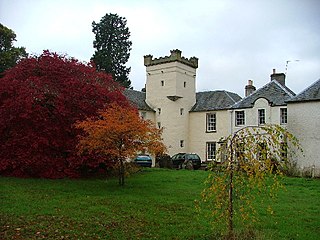
Moniack Castle is a 16th-century tower house located 7 miles (11 km) west of Inverness, and just south of Beauly in Highland, Scotland. The castle was built in 1580 by members of the Clan Fraser. The castle is protected as a category B listed building.

Kiltarlity is a small village in the Highland council area of Scotland. It is 12 miles (19 km) west of Inverness and 2.5 miles (4.0 km) south of Beauly, on the south bank of the Bruiach Burn. It has a population of under 1,000 people, and a local primary school, Tomnacross Primary. Lovat Shinty Club play at Kiltarlity, on a pitch beside the village's main street, Balgate Drive.
Aigas is a small hamlet in the Highland Council area of Scotland. It is 5 miles (8 km) southwest of Beauly and 15 miles (24 km) west of Inverness, on the north bank of the River Beauly. Crask of Aigas is nearby, to the northeast.
Struy is a small village at the end of Glen Strathfarrar, about 15 km south-west of Beauly in the Highland council area of Scotland.
Lentran is a small hamlet in the Highland council area of Scotland. It is 1.8 miles (3 km) east of Kirkhill and 5 miles (8 km) west of Inverness, on the south shore of the Beauly Firth.

Alice Spencer, Countess of Derby was an English noblewoman from the Spencer family and noted patron of the arts. Poet Edmund Spenser represented her as "Amaryllis" in his eclogue Colin Clouts Come Home Againe (1595) and dedicated his poem The Teares of the Muses (1591) to her.
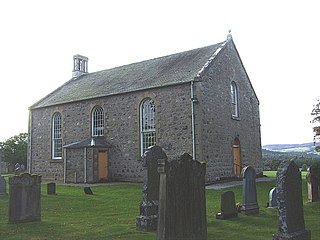
Tomnacross is a small hamlet and part of the village of Kiltarlity, about 20 km west of the city of Inverness in the Highland Council area of Scotland. It is the location of the Kiltarlity village school, Kiltarlity Church, and a cemetery. There are also several houses in the area. The Tartan Heart Festival takes place nearby on the Belladrum Estate.

Alatskivi Castle is a neo-Gothic castle in Alatskivi, Estonia. Dating to the 17th century, it is situated in Peipsiääre Parish, Tartu County. It was rebuilt in the late 19th century by Baron Arved von Nolcken, modeled on the royal residence of Balmoral in Scotland. A renovation occurred between 2005 and 2011. Five rooms on the first floor house the Eduard Tubin museum, which documents his accomplishments as a music composer and conductor.
